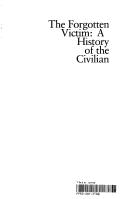| Listing 1 - 10 of 84 | << page >> |
Sort by
|
Book
ISBN: 1421412225 9781421412221 9781421412214 1421412217 Year: 2014 Publisher: Baltimore
Abstract | Keywords | Export | Availability | Bookmark
 Loading...
Loading...Choose an application
- Reference Manager
- EndNote
- RefWorks (Direct export to RefWorks)
War and society --- War casualties --- History --- United States --- Social aspects. --- Psychological aspects. --- Casualties.

ISBN: 1283396807 9786613396808 3110204517 9783110204513 3110181487 Year: 2004 Publisher: Berlin de Gruyter
Abstract | Keywords | Export | Availability | Bookmark
 Loading...
Loading...Choose an application
- Reference Manager
- EndNote
- RefWorks (Direct export to RefWorks)
Gilt das Verbot der Tötung Unschuldiger absolut oder darf selbst diese fundamentale Moralnorm unter Ausnahmebedingungen verletzt werden? Wir leben in einer Welt voller Gefahren. Das Leben von Menschen wird bedroht durch verbrecherische Diktaturen, terroristische Anschläge, technische Havarien und Katastrophen verschiedener Art. Dürfen solche Gefahren notfalls auch dann bekämpft werden, wenn dabei Unschuldige getötet werden oder ihr Tod in Kauf genommen werden muss? Das Buch gibt eine moralphilosophische Antwort auf diese politisch, ethisch und rechtlich umstrittene Frage. Lothar Fritze analysiert das Rechtsdogma der Nichtabwägungsfähigkeit menschlichen Lebens und fragt, wie sich das Verbot der Tötung Unschuldiger mit der verbreiteten moralischen Intuition vereinbaren lässt, wonach in Extremfällen durchaus einige wenige unschuldige Menschen geopfert werden dürfen, um sehr viele andere Unschuldige zu retten. We live in a world full of dangers. Human life is at risk from criminal dictatorships, terrorist attacks, technical disasters and catastrophesof various kinds. In an emergency, is it legitimate to counter such perils if that means that innocent life has to be taken or put at risk of death? The book gives a moral philosopher's response to this politically, ethically and legally controversial question.
Political ethics. --- Civilian war casualties. --- Victims. --- Persons --- Casualties, Civilian war --- Civilian casualties of war --- War casualties --- Ethics, Political --- Ethics in government --- Government ethics --- Political science --- Politics, Practical --- Ethics --- Civics --- Moral and ethical aspects --- Civilian war casualties --- Political ethics --- Victims
Book
ISBN: 0309062314 9786610186389 1280186380 0309568609 9780309568609 0309062134 9780309062312 Year: 1986 Publisher: Washington, D.C. National Academy Press
Abstract | Keywords | Export | Availability | Bookmark
 Loading...
Loading...Choose an application
- Reference Manager
- EndNote
- RefWorks (Direct export to RefWorks)
Fire prevention. --- Fire protection engineering. --- Fire safety --- Buildings --- Fires --- Prevention of fires --- Fires and fire prevention --- Prevention --- Engineering --- Fire protection engineering --- Public safety --- Insurance engineering --- Smoke --- Casualties in fires --- Fire casualties --- Fire deaths --- Fire victims --- Mass casualties --- Casualties. --- Physiological effect.
Book
ISBN: 0199977321 9780199977321 0199346178 9780199346172 9780199977307 0199977305 9780199977314 0199977313 Year: 2013 Publisher: Oxford Oxford University Press
Abstract | Keywords | Export | Availability | Bookmark
 Loading...
Loading...Choose an application
- Reference Manager
- EndNote
- RefWorks (Direct export to RefWorks)
A popular myth emerged in the late 1990s: in 1900, wars killed one civilian for every eight soldiers, while contemporary wars were killing eight civilians for every one soldier. The neat reversal of numbers was memorable, and academic publications and UN documents regularly cited it. The more it was cited, the more trusted it became. In fact, however, subsequent research found no empirical evidence for the idea that the ratio of civilians to soldiers killed in war has changed dramatically. But while the ratios may not have changed, the political significance of civilian casualties has risen tremendously.Over the past century, civilians in war have gone from having no particular rights to having legal protections and rights that begin to rival those accorded to states. The concern for civilians in conflict has become so strong that governments occasionally undertake humanitarian interventions, at great risk and substantial cost, to protect strangers in distant lands. I n the early 1990s, the UN Security Council authorized military interventions to help feed and protect civilians in the Kurdish area of Iraq, Somalia, and Bosnia. And in May 2011 , Barack Obama 's National Security Advisor explained the United States' decision to support NATO's military intervention in these terms "When the president made this decision, there was an immediate threat to 700,000 Libyan civilians in the town of Benghazi. We've had a success here in terms of being able to protect those civilians."Counting Civilian Casualties aims to promote open scientific dialogue by high lighting the strengths and weaknesses of the most commonly used casualty recording and estimation techniques in an understandable format. Its thirteen chapters, each authoritative but accessible to nonspecialists, explore a variety of approaches, from direct recording to statistical estimation and sampling, to collecting data on civilian deaths caused by conflict. The contributors also discuss their respective advantages and disadvantages, and analyze how figures are used (and misused) by governments, rebels, human rights advocates, war crimes tribunals, and others. In addition to providing analysts with a broad range of tools to produce accurate data, this will be an in valuable resource for policymakers, military officials, jou rnalists, human rights activists, courts, and ordinary people who want to be more informed--and skeptical--consumers of casualty counts.
Civilian war casualties --- Civilians in war --- Guerre civile --- Guerre --- Statistics. --- Case studies --- Pertes --- Statistiques --- Etudes de cas --- Participation des civils --- War --- War and society --- Casualties, Civilian war --- Civilian casualties of war --- War casualties --- Civil War --- Military History --- History
Book
ISBN: 162349561X 9781623495619 9781623495602 Year: 2017 Publisher: College Station
Abstract | Keywords | Export | Availability | Bookmark
 Loading...
Loading...Choose an application
- Reference Manager
- EndNote
- RefWorks (Direct export to RefWorks)
Soldiers --- War casualties --- Athletes --- Casualties, War --- War --- War victims --- War wounds --- Casualties --- Casualties (Statistics, etc.) --- Tillman, Pat, --- Kalsu, Bob, --- Kinnick, Nile C. --- Baker, Hobey. --- Fish, Hamilton, --- Baker, Hobart Amory Hare
Book
ISBN: 1611211905 9781611211900 9781611211894 Year: 2015 Publisher: [Place of publication not identified]
Abstract | Keywords | Export | Availability | Bookmark
 Loading...
Loading...Choose an application
- Reference Manager
- EndNote
- RefWorks (Direct export to RefWorks)
Soldiers' bodies, Disposition of --- History --- United States --- History --- Casualties.
Book
ISBN: 1476635161 9781476635163 9781476674568 1476674566 Year: 2019 Publisher: Jefferson, North Carolina
Abstract | Keywords | Export | Availability | Bookmark
 Loading...
Loading...Choose an application
- Reference Manager
- EndNote
- RefWorks (Direct export to RefWorks)
Saipan, Battle of, Northern Mariana Islands, 1944. --- World War, 1939-1945 --- Mass suicide --- Civilian war casualties --- Casualties --- Campaigns
Book
ISBN: 0833078216 0833078194 0833078356 9780833078216 9780833078193 9780833078209 0833078208 9780833078360 0833078364 9780833078353 Year: 2013 Publisher: Santa Monica, CA : RAND Corporation,
Abstract | Keywords | Export | Availability | Bookmark
 Loading...
Loading...Choose an application
- Reference Manager
- EndNote
- RefWorks (Direct export to RefWorks)
War has always been a dangerous business, bringing injury, wounds, and death, and--until recently--often disease. What has changed over time, most dramatically in the last 150 or so years, is the care these casualties receive and who provides it. This book looks at the history of how humanity has cared for its war casualties and veterans, from ancient times through the aftermath of World War II.
Battle casualties -- Medical care -- History. --- Medicine, Military -- History. --- Veterans -- Medical care -- History. --- War casualties -- Medical care -- History. --- War casualties --- Battle casualties --- Veterans --- Medicine, Military --- Health --- Medicine --- Diseases --- Occupational Groups --- Persons --- Health Occupations --- Population Characteristics --- Named Groups --- Health Care --- Disciplines and Occupations --- Military Personnel --- Veterans Health --- Military Medicine --- Wounds and Injuries --- Medical care --- History --- History. --- Casualties, War --- War --- Combat veterans --- Ex-military personnel --- Ex-service men --- Military veterans --- Returning veterans --- Vets (Veterans) --- War veterans --- Military medicine --- Battles --- Casualties, Battle --- Combat casualties --- Casualties --- Casualties (Statistics, etc.) --- War victims --- War wounds --- Armed Forces --- Retired military personnel --- Medicine, Naval --- Military hospitals --- Military hygiene --- Combat --- Medical aspects --- Relief of sick and wounded
Book
ISBN: 0191022047 0191781398 9780191781391 9780191022043 9780198712985 0198712987 Year: 2015 Publisher: Oxford
Abstract | Keywords | Export | Availability | Bookmark
 Loading...
Loading...Choose an application
- Reference Manager
- EndNote
- RefWorks (Direct export to RefWorks)

ISBN: 0913750190 Year: 1982 Publisher: Chicago Precedent
Abstract | Keywords | Export | Availability | Bookmark
 Loading...
Loading...Choose an application
- Reference Manager
- EndNote
- RefWorks (Direct export to RefWorks)
Civilian war casualties. --- Just war doctrine. --- War --- Moral and ethical aspects.
| Listing 1 - 10 of 84 | << page >> |
Sort by
|

 Search
Search Feedback
Feedback About UniCat
About UniCat  Help
Help News
News